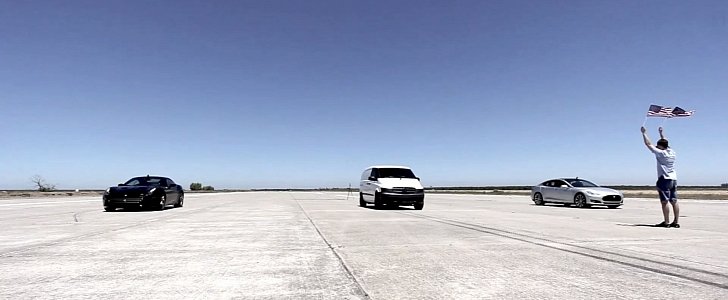Off the line acceleration is half of what made Tesla the brand it is today. Elon Musk explained how the Roadster was just a way of making people understand that EVs can be fun, opening the door for the company's second car, the Tesla Model S.
The luxury sedan quickly established itself as a respected presence on the dragstrip, even though the inability to tune its performance meant that pretty fast, everybody knew just what to expect from the electric car. Luckily, they could expect quite a lot.
With the introduction of the Ludicrous mode, the two-motor Tesla Model S P90D could accelerate to 60 mph (97 km/h) in under three seconds. The g-forces generated by this accelerations were enough to keep people pinned in their seats no matter how many crunches they did at the gym. It's brutal.
Of course, after Tesla did the hard work, other companies are now looking to take advantage of the EV's newly gained image of fast, powerful cars. One of these companies is called Atieva, and it seems to have all the right ingredients: it's got financial backing from a wealthy Chinese investor, and it's got the know-how from former Model S Chief Engineer, Peter Rawlinson.
What Atieva also has is a test vehicle, and its name is "Edna." It's a Mercedes-Benz Vito van that the engineers have fitted with the electric powertrain that will later motivate the company's first product, an electric luxury sedan aimed to compete directly with the Model S.
Why choose a van? Well, it probably offers enough room for all the testing equipment while also passing relatively unnoticed. Well, at least when it's not accelerating faster than a traditional hypercar. And just have a look at the video below and ask yourself this: why the hell not? Atieva says that when mounted on the chassis and body of the final product, the ensemble will be able to reach the target speed of 60 mph even faster - 0.4 seconds faster, to be more precise, which would put it just under Tesla's 2.8 seconds time.
This is how Atieva describes its test vehicle: “Under Edna’s skin are two electric motors, two sets of power electronics, two gearboxes, one battery capable of storing 87 kWh of energy and outputting over 900 horsepower, plus all of the software to make the components play nicely together. With Edna we are able to test various aspects of the powertrain system, including motor control algorithms, regenerative braking behaviors, accelerator pedal feel, and cooling strategies, to name a few.”
But one image is worth a thousand words, and one video, a million, so Atieva decided to showcase the huge potential of its powertrain by filming a drag race. Alongside Edna, there were a Ferrari California and a Tesla Model S lining up. Unfortunately, we don't know the exact specs of the Tesla, but considering how close it came to the van, it was probably one of the top versions, probably a 90D.
With the introduction of the Ludicrous mode, the two-motor Tesla Model S P90D could accelerate to 60 mph (97 km/h) in under three seconds. The g-forces generated by this accelerations were enough to keep people pinned in their seats no matter how many crunches they did at the gym. It's brutal.
Of course, after Tesla did the hard work, other companies are now looking to take advantage of the EV's newly gained image of fast, powerful cars. One of these companies is called Atieva, and it seems to have all the right ingredients: it's got financial backing from a wealthy Chinese investor, and it's got the know-how from former Model S Chief Engineer, Peter Rawlinson.
What Atieva also has is a test vehicle, and its name is "Edna." It's a Mercedes-Benz Vito van that the engineers have fitted with the electric powertrain that will later motivate the company's first product, an electric luxury sedan aimed to compete directly with the Model S.
Why choose a van? Well, it probably offers enough room for all the testing equipment while also passing relatively unnoticed. Well, at least when it's not accelerating faster than a traditional hypercar. And just have a look at the video below and ask yourself this: why the hell not? Atieva says that when mounted on the chassis and body of the final product, the ensemble will be able to reach the target speed of 60 mph even faster - 0.4 seconds faster, to be more precise, which would put it just under Tesla's 2.8 seconds time.
This is how Atieva describes its test vehicle: “Under Edna’s skin are two electric motors, two sets of power electronics, two gearboxes, one battery capable of storing 87 kWh of energy and outputting over 900 horsepower, plus all of the software to make the components play nicely together. With Edna we are able to test various aspects of the powertrain system, including motor control algorithms, regenerative braking behaviors, accelerator pedal feel, and cooling strategies, to name a few.”
But one image is worth a thousand words, and one video, a million, so Atieva decided to showcase the huge potential of its powertrain by filming a drag race. Alongside Edna, there were a Ferrari California and a Tesla Model S lining up. Unfortunately, we don't know the exact specs of the Tesla, but considering how close it came to the van, it was probably one of the top versions, probably a 90D.





